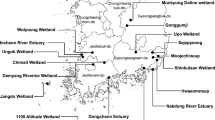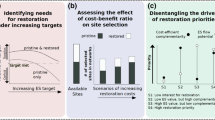Abstract
We examined multi-objective environmental management as applied to pursuing concurrent goals of water treatment, biodiversity and promotion of recreation in constructed wetlands. A case study of a wetland established to treat landfill leachate, increase biodiversity, and promote recreation was evaluated. The study showed that attempts to combine pollution management with activities promoting biodiversity or recreation are problematic in constructed wetlands. This could be because the typical single-objective focus of scientific research leads to contradictions when planning, implementing and assessing the multi-objective use of wetlands. In the specific case of wetland filters for landfill leachate treatment, biodiversity, and recreation, there is a need for further research that meet practical needs to secure positive outcomes.
Similar content being viewed by others
References
Adolfsson, G., Nordh, C. and Hellgren, G.: 1972, Örebro Kommun. Deponering av ej förbehandlat avfall samt avloppsslam på markområdet Venan i Örebro, K-Konsult, Avdelningen för avfallshantering, Stockholm och Örebro.
Barr, M. J. and Robinson, H. D.: 1999, 'Constructed wetlands for landfill leachate treatment', Waste Manage. Res. 17, 498–504.
Carley, M. and Christie, I.: 1992, Managing Sustainable Development, Earthscan Publications Ltd, London.
Claesson, E. and Klingnéus, S.: 1999, 'Hjälmaren-ett program kring en sjö i förändring', in L. Skoghäll (ed.), Från bergslag och bondebygd 1999. Hjälmaren, KB Kumla Tryckeri, Örebro.
Creighton, J. H., Sayler, R. D., Tabor, J. E. and Monda, M. J.: 1997, 'Effects of wetland excavation on avian communities in Eastern Washington', Wetlands 17(2), 216–227.
Dobberteen, R. A. and Nickerson, N. H.: 1991, 'Use of created Cattail (Typha) wetlands in mitigation strategies', Environ. Manage. 15(6), 797–808.
Fagerlind, T.: 1993, Yt-och grundvattenpåverkan av Venanas avfallsupplag, SGU-Sveriges Geologiska Undersökning, Uppsala.
Galatowitsch, S. M., Whited, D. C. and Tester, J. R.: 1999, 'Development of community metrics to evaluate recovery of Minnesota wetlands', J. Aquatic Ecosys. Stress Recovery 6, 217–234.
Gearheart, R. A. and Higley, M.: 1993, 'Constructed Open Surface Wetlands: The Water Quality Benefits and Wildlife Benefits-City of Arcata, California', in G. A. Moshiri (ed.), Constructed Wetlands for Water Quality Improvement, Lewis Publishers, Boca Raton, Florida, 561–567.
Gilvear, D. J. and Bradley, C.: 2000, 'Hydrological monitoring and surveillance for wetland conservation and management; a UK perspective', Phys. Chem. Earth 25(7-8), 571–588.
Golder Associates AB: 1994, Lokal lakvattenbehandling vid Venans avfallsupplag, 94-600, Golder Associates, AB, Göteborg.
Haarstad, K. and Maehlum, T.: 1999, 'Important aspects of long-term production and treatment of municipal solid waste leachate', Waste Manage. Res. 17(6), 470–477.
Horne, M. T. and Dunson, W. A.: 1995, 'The interactive effects of low pH, toxic metals, and DOC on a simulated temporary pond community', Environ. Poll. 89(2), 155–161.
Innis, S. A., Naiman, R. J. and Elliott, S. R.: 2000, 'Indicators and assessment methods for measuring the ecological integrity of semi-aquatic terrestrial environments', Hydrobiol. 422/423, 111–131.
Kadlec, R. H. and Knight, R. L.: 1996, Treatment Wetlands, Lewis Publishers, Boca Raton, Florida.
Larsson, K.: Personal communication, Environmental investigator, Örebro municipality, 1999
Maeluem, T.: 1995, 'Treatment of landfill leachate in on-site lagoons and constructed wetlands', Water Sci. Techn. 32(3), 129–135.
Martin, C. D. and Johnson, K. D.: 1995, 'The use of extended aeration and in-series surface-flow wetlands for landfill leachate treatment', Water Sci. Techn. 32(3), 119–128.
Martin, C. D. and Moshiri, G. A.: 1994, 'Nutrient reduction in an in-series constructed wetland system treating landfill leachate', Water Sci. Techn. 29(4), 267–272.
Mensing, D. M., Galatowitsch, S. M. and Tester, J. R.: 1998, 'Anthropogenic effects on the biodiversity of riparian wetlands of a northern temperate landscape', J. Environ. Manage. 53, 349–377.
Naturvårdsverket: 1999, Bedömningsgrunder för miljökvalitet. Sjöar och vattendrag, 4913, Naturvårdsverket, Stockholm.
Naturvårdsverket: 2001, From Swampy Pits and Mosquito-hells to Flourishing Wetlands, 5146, The Swedish Environmental Protection Agency, Stockholm.
Rey, B. J. M., Colomer, M. G. S. and Levassor, C.: 1999, 'Effects of area, environmental status and environmental variation on species richness per unit area in Mediterranean wetlands', J. Vege. Sci. 10, 275–280.
Rosenberg, M.: 1998, 'Har vi glömt Oset?', Fåglar i Närke 3, 102–103.
Rydén, S.: 1972, PM angående sophämtningens organisation och omfattning i Örebro Kommun efter den 1 januari 1973, Sammanträdesprotokoll 10, §384, Handlingar, 1972 Nr 220.
Sandgren, L.: Personal communication, Ornithologist, Örebro municipality 2000.
Sandgren, L.: Personal communication, Ornithologist, Örebro municipality 2001.
Simmons, E.: 1999, 'Restoration of landfill sites for ecological diversity', Waste Manage. Res. 17, 511–519.
SMHI: Personal communication, Swedish Meteorological and Hydrological Institute, 1999
Staubitz,W.W, Surface, J. M., Steenhuis, T. S., Perverly, J. H., Lavine, M. J., Weeks, N. C., Sanford, W. E. and Kopka, R. J.: 1989, 'Potential Use of ConstructedWetlands to Treat Landfill Leachate', in D. A. Hammar (ed.), Constructed Wetlands for Wastewater Treatment Municipal, Industrial and Agricultural, Lewis Publishers, INC, Chelsea, Michigan, 735–742.
Tekniska Förvaltningen: 1998, Miljörapport för Venan 1997, Tekniska Förvaltningen, Örebro.
Tekniska Förvaltningen: 1999, Miljörapport för Venan 1998, Tekniska Förvaltningen, Örebro.
Tekniska Förvaltningen: 2000, Miljörapport för Venan 1999, Tekniska Förvaltningen, Avfallsverket, Örebro.
Tekniska Förvaltningen: 2001, Miljörapport för Venan 2000, Tekniska Förvaltningen, Örebro.
Tekniska Förvaltningen: 1994, Täckningsplan för Venans nedlagda avfallsupplag, Tekniska Förvaltningen, Örebro
Yallop, M. L. and O'Connell, M.: 2000, 'Wetland creation: early stages in colonization of phytoplankton and submerged macrophytes in hypereutrophic freshwater lagoons', Aqua. Conserv.: Marine Freshw. Ecosys. 10, 305–309.
Young, P.: 1996, 'The “new science” of wetland restoration', Environ. Techn. 30(7), 292–296.
Zedler, J. B.: 2000, 'Progress in wetland restoration ecology', Trends Ecol. Evol. 15(10), 402–407.
Örebro Kommun: 1995, Skötselplan för naturreservatet Rynningeviken, 138-95, Örebro Kommun, Örebro.
Author information
Authors and Affiliations
Corresponding author
Rights and permissions
About this article
Cite this article
Benyamine, M., Bäckström, M. & Sandén, P. Multi-Objective Environmental Management in Constructed Wetlands. Environ Monit Assess 90, 171–185 (2004). https://doi.org/10.1023/B:EMAS.0000003577.22824.8e
Issue Date:
DOI: https://doi.org/10.1023/B:EMAS.0000003577.22824.8e




